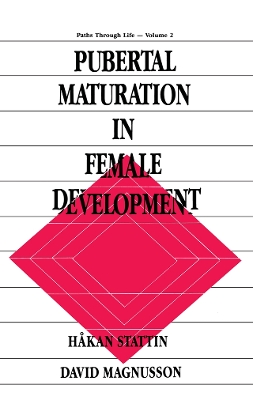Paths Through Life
3 total works
Pubertal Maturation in Female Development
by Hkan Stattin, David Magnusson, and Hakan Stattin
Research on physical maturity has demonstrated conclusively that the assumption of an age-homogenous development does not always hold true. This volume presents a biosocial model focusing on the role of individual differences in biological maturation to be used as a framework for empirical studies exploring adolescent female development. The longitudinal design of the research program offers the possibilities to examine both short- and long-term consequences for individual variations in pubertal development. In the present volume, the data for these analyses consist of a broad range of biological, mental, psychological, behavioral, and social factors extending from the age of 10 to the age of 30. Some of the questions the present volume attempts to answer are:
* Are variations in the timing of pubertal development among girls related to their psychological and social life situation in the adolescent years? If so, when is the relation most prominent? In what areas is the relation most prominent? How does the relation come about?
* Do interindividual differences in physical maturation have any long-term consequences for adult life? If so, in what areas, for which girls, and through which developmental processes does pubertal development operate? The long-term consequences are a major concern addressed in considerable detail.
Studying individual Development in An interindividual Context
by Lars R. Bergman, David Magnusson, and Bassam M. El-Khouri
This book describes an alternative, person-oriented approach in which the focus is on the individual as a functioning whole. The authors take as their theoretical starting points the holistic-interactionistic research paradigm expounded by David Magnusson and others, and the new developmental science in which connections and interactions between different systems (biological, psychological, social, etc.) are stressed. They present a quantitative methodology for preserving--to the maximum extent possible--the individual as a functioning whole that is largely based on work carried out in the Stockholm Laboratory for Developmental Science over the past 20 years.
The book constitutes a complete introductory guide to the person-oriented approach. The authors lay out the underlying theory, a number of basic methods, the necessary computer programs, and an extensive empirical example. (The computer programs have been collected into a statistical package, SLEIPNER, that is freely accessible on the Internet. The empirical example deals with boys' school adjustment from a pattern perspective and covers both positive and negative adaptation.)
Studying Individual Development in an Interindividual Context: A Person-Oriented Approach will be crucial reading for all researchers who seek to understand the complexities of human development and for their advanced students.
Throughout their investigation the authors interpret individuals' patterns as characterizing processes that underlie women's differential development. They illustrate that a research strategy oriented toward pattern analysis and related methodology reveals information that is generally obscured in more traditional variable-oriented designs. They also argue that a pattern approach is particularly suited to the tenets of modern interactionism, which provides the theoretical foundation of the study.


